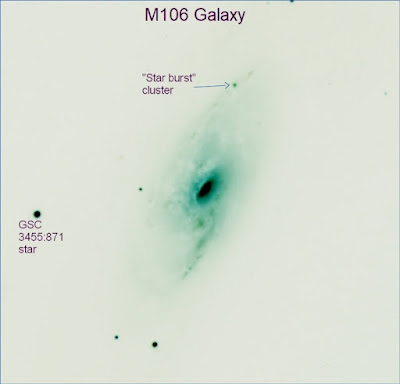Physics Photo of the Week
Physics Photo of the Week
April 4, 2025
Galaxy M106 - Photo by Donald Collins - College View Observatory
Galaxy M106 - the 106th entry in Messier's famous catalog of deep sky objects - lies about 20-25 million light years from Earth. It is about 10 times further than the Andromeda Galaxy and about twice as far away as the recently featured Galaxy M87. As with most galaxies, M106 contains on the order of 100 billion stars, and most likely has a supermassive black hole lurking deep in its core. Celestial south is up in this photo.
This galaxy is interesting in that there are many star-forming regions within the spiral arms. It's also rather "clumpy". The clouds of dust and stars are not very evenly distributed. The clumps of new young stars are the clumps that appear brighter and "bluer" in the photo. The clumps of stars eventually will dissipate and result in open clusters similar to the Pleiades (Seven Sisters) star cluster in our own Milky Way Galaxy.
One of the brighter star clusters in the M106 galaxy looks like a star - it's near the top of the galaxy in the photo. It looks much smaller than the bright star in the left side of the photo outside the galaxy. The sizes of stars are deceptive in astronomical photos. All stars viewed from Earth are mere pinpoints of light with no dimensions due to the vast distances of the stars. Even in the most powerful telescopes the physical sizes of the stars are zero. The stars' images are spread out due to the diffraction of starlight around the aperture of the telescope. The larger the diameter of the telescope aperture, the smaller the diffraction size of the stars' images.
The diagram at right shows the profile of any of the stars' images in the photo. The brighter the star the higher the maximum of the profile, but the overall shape of the profile is the same shape no matter the brightness of the star. The fainter stars show the same shape at a different scale. The shape of a star profile is called a Gaussian curve - named after the German physicist and astronomer Karl Friedrich Gauss whose career spanned the first half of the 1800's. A gaussian star profile is characterized by a parameter called the "Full Width at Half Maximum" (FWHM). The FWHM for the Gaussian profile in the image above is shown by the arrows across the mid-height of the profile. The remarkable property of the Gaussian star images is that the FWHM is the same no matter the brightness of the stars. The star profile's FWHM is a property of the optics of the telescope - mainly the diameter.
A small extended object like a luminous "cloud" or a cloud of stars in a galaxy would show a larger FWHM than the Gaussian image of a point-like star. The negative image at left shows the galaxy. The "star burst" cluster and the catalog label for the relatively bright star are also indicated. Using digital image analysis tools, I carefully made profiles of both the GSC star and the star burst cluster. These profiles have been scaled to the same maximum brightness. The plots below indicate the relative brightness of the star profiles. The horizontal axis is the pixel position across the star's or cluster's image. The vertical axis represents the brightness. Both brightness profiles have been scaled to the maximum of "1" for easy comparison.
These profiles are shown in the image at right. The narrower curve (black) represents the bright star's profile. The wider peak (blue) is the profile for the "star burst" cluster at within a spiral arm of the galaxy. The bright star, being much brighter than the star burst has been scaled to the same height as the starburst profile. The starburst consists of hundreds of stars close together in a tight very young cluster. Over the time span of hundreds of millions of years the starburst profile will most like expand to resemble the other larger, fainter clouds of stars in the galaxy.
Large telescopes, especially the Hubble Space Telescope, easily resolve the "star burst" cluster into a sizeable image of individual stars. The small 14 inch telescope in the College View Observatory does not resolve the stars in the starburst cluster. The complicated examination of the profiles of the images is necessary for distinguishing clusters from stars with small telescopes. The relatively large peak brightness of the star burst cluster and the small physical size indicate that this cluster is very "young" (less than 1 million years) cluster recently formed from the gravitational contraction of a dust cloud in the galaxy.
======================================================================
Physics Photo of the Week is published periodically during the academic year on Fridays by Donald F. Collins, professor emeritus of Warren Wilson College. These photos feature interesting phenomena in the world around us. Students, faculty, and others are invited to submit digital (or film) photographs for publication and explanation. Atmospheric phenomena are especially welcome. Please send any photos to dcollins@warren-wilson.edu.
All photos and discussions are copyright by Donald Collins or by the person credited for the photo and/or discussion. These photos and discussions may be used for private individual use or educational use. Any commercial use without written permission of the photoprovider is forbidden.







Comments
Post a Comment